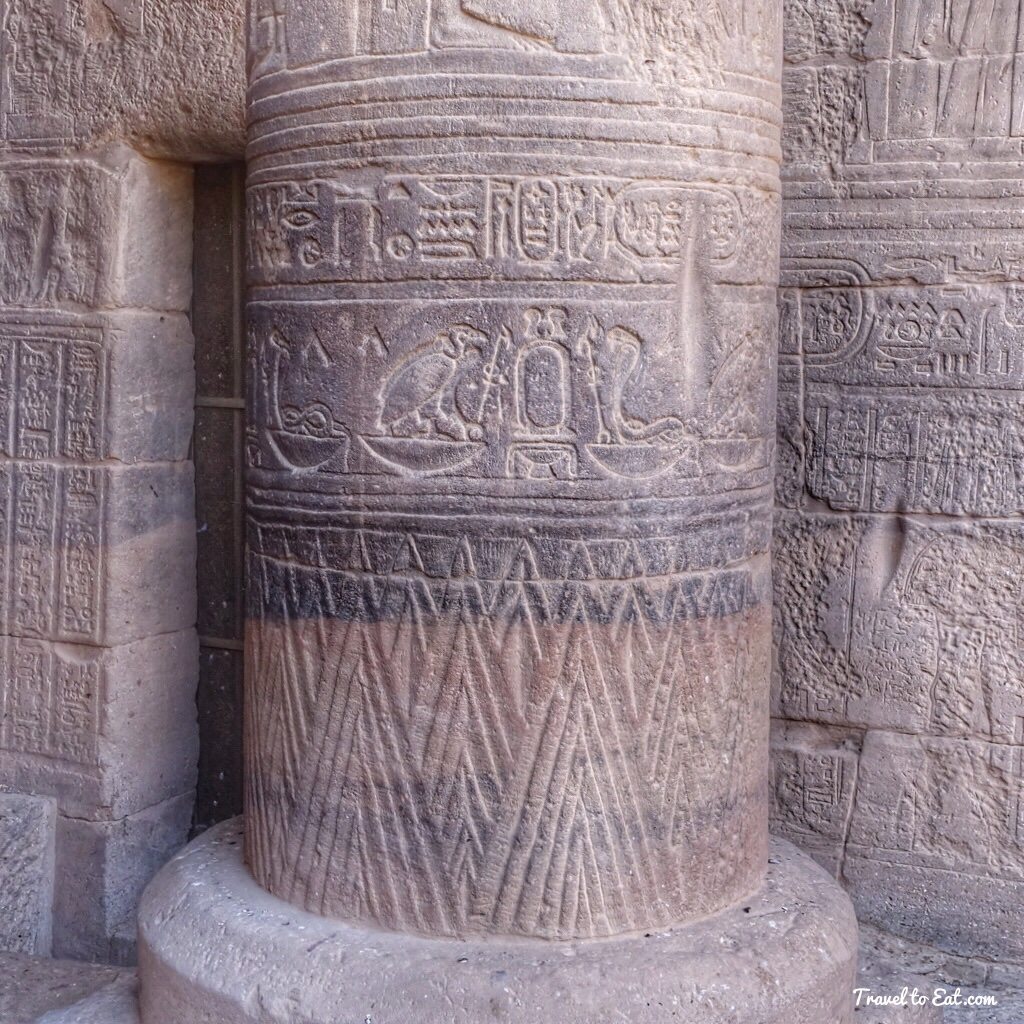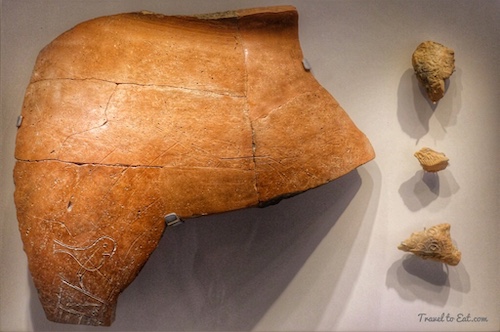
When I was in Egypt last summer I visited the Temple of Isis from Philae and I, like many others before me, was fascinated by the hieroglyphs on the walls. Early hieroglyphics date back as far as 3,300 BCE, and continued to be used up until the end of the fourth century CE, when non-Christian temples were closed and their monumental use was no longer necessary. Hieroglyphs are a complicated business and my intention is to interpret just a few hieroglyphs to give an idea of how it is accomplished. Many ancient Egyptian symbols were used as amulets of protection, or they were used to bring good fortune. Many of the same ancient Egyptian symbols were also used in religious and magical rituals for the living and also for the dead. Hieroglyphs were based on everyday objects along the Nile river which may not be as familiar to us today. As the famous Jean-François Champollion, the man who deciphered the Rosetta stone, commented; “It is a complex system, writing figurative, symbolic, and phonetic all at once, in the same text, the same phrase, I would almost say in the same word”.
History of Egyptian Hieroglyphs
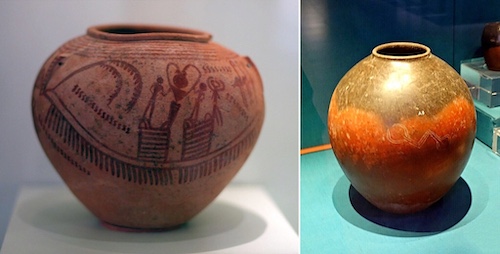
Hieroglyphs emerged from the preliterate artistic traditions of Egypt. Suggestions that writing was imported from Mesopotamia are controversial and it is generally accepted that hieroglyphs were an independent invention of Egyptians. For example, symbols on Gerzean pottery from around 4000 BCE resemble hieroglyphic writing. In the era of the Old Kingdom, the Middle Kingdom and the New Kingdom, about 800 hieroglyphs existed. By the Greco-Roman period, they numbered more than 5,000.
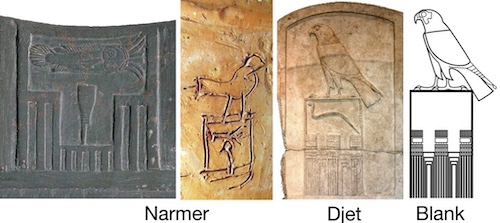
The serekh used to frame the Pharaoh's name was the predecessor to the cartouche and was used in predynastic and First Dynasty (3100-2800 BC) times. The serekh was an ornamentic vignette, combining a front view of a palace facade and a plan (top view) of the royal courtyard topped by a falcon representing the god Horus. The symbol of the pharaoh was placed in the empty courtyard area. The symbols of Narmer (3100s BC), the first pharaoh of the First Dynasty was a whiskered catfish with a chisel (interesting choice). The symbol of Djet (3008-2975 BC), the third pharaoh of the First Dynasty was a serpent.
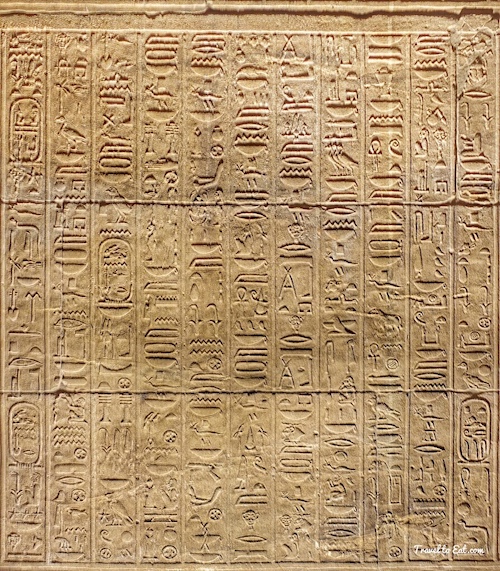
Visually hieroglyphs are all more or less figurative, they represent real or illusional elements, sometimes stylized and simplified, but all generally perfectly recognizable in form. A hieroglyph can represent a word (ideagram or logogram), one or several sounds, or a silent determinative (which makes clear what the sign means). The same symbol can serve different purposes in different contexts. Hieroglyphs were for public purposes, used on stone monuments and in tombs. Egyptian hieroglyphic writing does not normally indicate vowels, unlike cuneiform, and for that reason has been labelled by some an “abjad” alphabet (alphabet without vowels) like Hebrew and Arabic. An abjad is a type of writing system where each symbol always or usually stands for a consonant, leaving the reader to supply the appropriate vowel. The name “abjad” (abjad أبجد) is derived from pronouncing the first letters of the Arabic alphabet in order. However, most modern abjads, such as Arabic, Hebrew, Aramaic and Avestan, are “impure” abjads, that is, they also contain symbols for some of the vowel phonemes. In the 9th century BC, the Greeks adapted the Phoenician script for use in their own language. The phonetic structure of the Greek language created too many ambiguities when the vowels went unrepresented, so the script was modified to include vowels. The Greek alphabet thus became the world's first to have symbols representing vowel sounds. By the 4th century, few Egyptians were capable of reading hieroglyphs, and monumental use of hieroglyphs ceased after the closing of all non-Christian temples in 391 AD.
Hieroglyph Basics
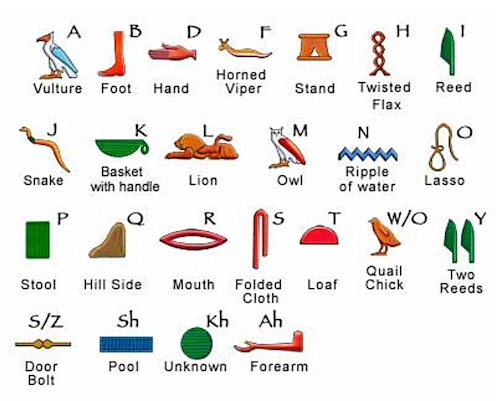
As I said above, hieroglyphs are symbols (logograms or ideagrams) of everyday objects and can also represent letters or sounds. As you can see in the figure above, each picture represents a single sound but can also represent the actual thing being represented. Just to be clear this is not a complete list of hieroglyphs, a much more complete list is the Gardiner's Sign List of common Egyptian hieroglyphs compiled by Sir Alan Gardiner (1879-1963). It is considered a standard reference in the study of Ancient Egyptian hieroglyphs. To differentiate which to read in a given sentence, they used “determinative signs” or additional signs or marks below, above or after the sign. A hieroglyph used as a logogram defines the object of which it is an image. Logograms are therefore the most frequently used common nouns; they are always accompanied by a mute vertical stroke indicating their status as a logogram. For example, consider the name Bob Smith in hieroglyphs:
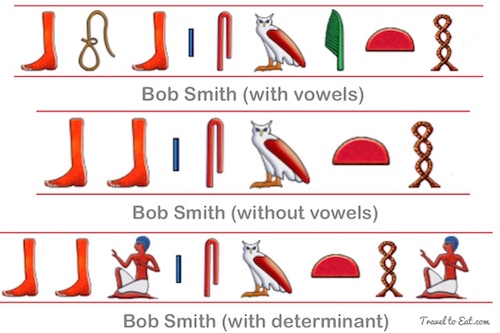
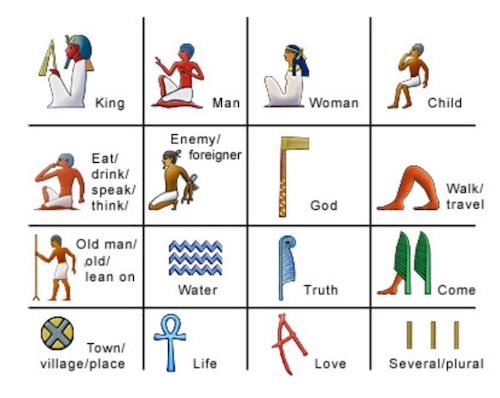
To begin, notice that I have separated the words with a vertical line. Hieroglyphs can be written left-right, right-left, top- down or bottom up but often have a line separating words. To read a horizontal line of text, we must begin at the end towards which the faces of the animate beings are turned, and continue reading by meeting their gaze. For Egyptians, the normal direction of writing was from right to left, as in Arabic. the layout must be pleasant to look at. To reach this, the signs are often grouped by 3 or 4 in virtual “square blocks”, called quadrats. The dimensions of the subject of the pictograms are not taken into account: an owl may be taller than a man. I looked at the sample block of hieroglyphs I presented above and I see no horizontal lines but I see other characters which serve the same purpose which I will discuss later. In this case with vowels, the name is pretty recognizable but without them, things get a little less clear. For example, even with vowels, Bob can be a problem, as in “bob for apples”. Without vowels bb could mean bib. To make sure you read this as the name “Bob”, we add a determinant of a man to the end of the word. This ensures you will read “Bob Smith” as a man. As you can imagine, this subject can get even more complicated though I will leave it here. If you want to get a good introduction to hieroglyphs, you might consider the Egyptian Hieroglyphs iPad app by Mark Millmore, the method I used to produce these diagrams. It is a fun app that you can use to send emails in hieroglyphs to your friends but desperately in need of a way to save the images to the camera roll and it has a limited range of glyphs with no way to add more. Wikipedia is also an excellent resource, with a fairly complete list of Gardiner's Sign List.
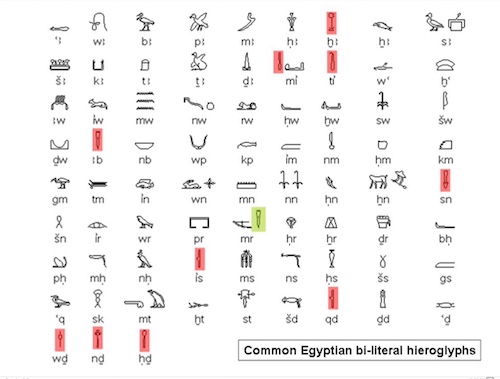
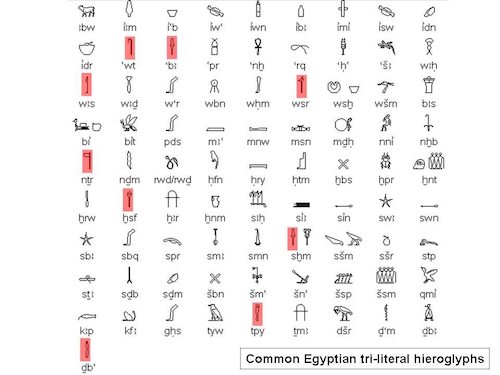
A word that consists of a single syllable (like English dog or cat) is called a monosyllable (and is said to be monosyllabic). Similar terms include disyllable (and disyllabic) for a word of two syllables (like water or weather); trisyllable (and trisyllabic) for a word of three syllables (like companion or resistance); and polysyllable (and polysyllabic), which may refer either to a word of more than three syllables or to any word of more than one syllable. In the International Phonetic Alphabet (IPA), the period ⟨.⟩ marks syllable breaks, such as in the word “astronomical” ⟨/æs.trə.nɑ.mɪ.kəl/⟩. In practice spaces are often used instead. Some of the popular two and three syllable symbols are shown above. If you really want to get into real world transliteration, there are many amateur forums devoted to the subject. In addition, I have used the Hieroglyphic Dictionary (Aaou) iPad app by JF Dumon and it is an excellent professional tool for more advanced users.
Sacred Symbols
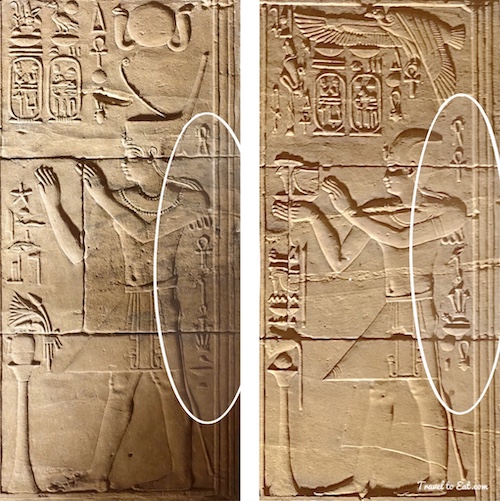
I would like to return to the two panels from the Temple of Isis from Philae that I used in the previous post. I am going to provide translations for a few more selected areas. To begin, I want to start with the vertical column of hieroglyphs on the right side of each panel. These include the well known ankh and most importantly the Sa, Was and Myhet symbol in the same phrase. To aid in the transliteration, I have made a figure with relevant symbols for the discussion.
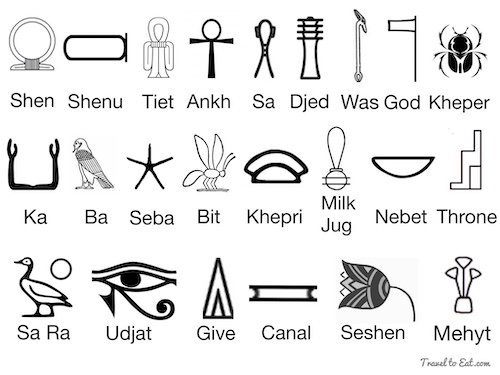
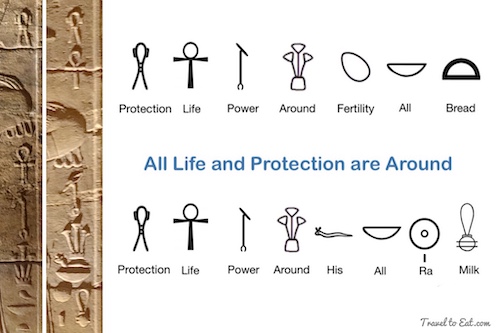
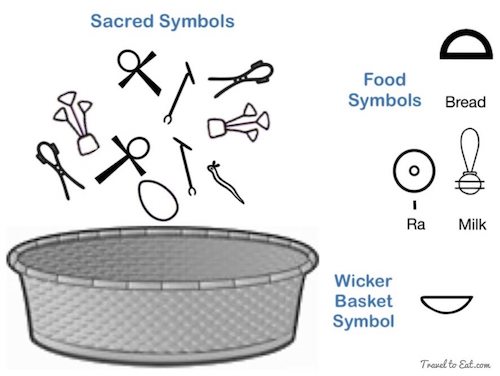
To be completely honest, I knew the transliteration as soon as I saw the Sa, Ankh, Was and Mehyt in the same famous phrase, all of the other symbols are just thrown in. The Nebet sign, meaning “all”, functions just like the basket it portrays, including everything above it. In a sense it acts as a determinant, ending the phrase. This is similar to Nechbet and Wadjet over the Nebet, meaning all of Upper and Lower Egypt. One scribe added power and fertility, the other added “his” and power. When the the old and well known symbols are used in a space alone, it indicates they are acting as the complex talismans they represent and not as phonetic sounds. These phrases would be known to everyone in the era in which they were written, repeated to them in front of the first pylon to the crowd in the processional by the priests and perhaps the pharoah himself. This reminds me of much the same scene when the Pope addresses the crowds in Saint Peter's square at the Vatican, repeating phrases they all know by heart. The more things change, the more they remain the same.
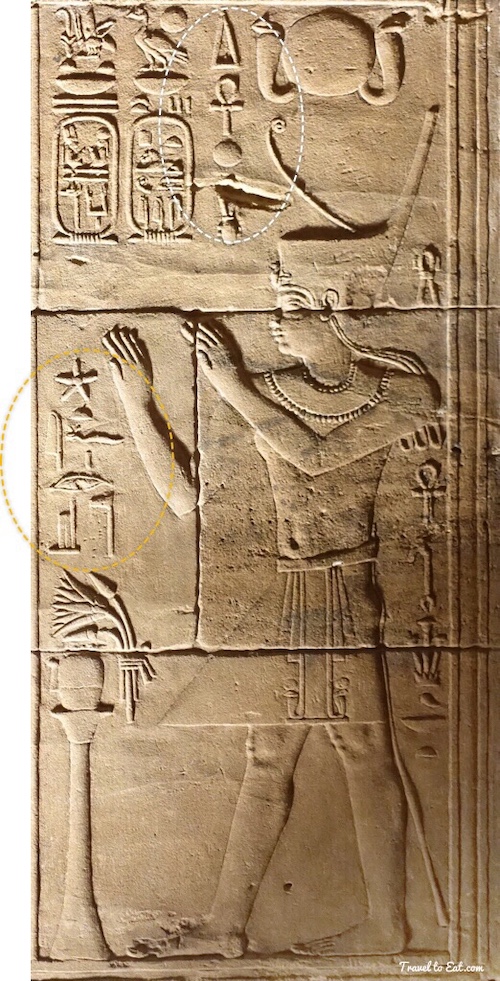
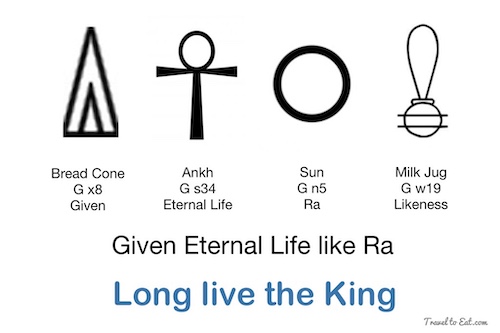
The ancient Egyptian Bread Cone is one of the oldest language hieroglyphs from Ancient Egypt. It was used in the early dynasties of Egypt, with usage at the time of the Pyramid Texts. The meaning of the Bread Cone is: “to give”, “present”.
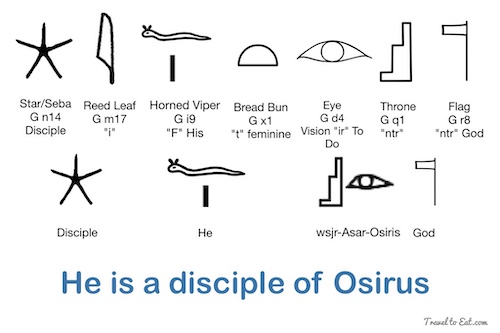
The Seba is the representation of star in Egyptian religious art. Patterned after a starfish, with five equidistant spokes, the seba was a symbol of the constellations, or star-gods. Enclosed in a circle, the seba represented the Duat, or otherworld, where the sun diappeared each night, and to which the souls of the dead ascended after death. The word seba means ‘learning’ or ‘discipline’ and is associated with doorways and gates. The eye and throne followed by the god flag as a determinant is definitely Osirus. The rest I am less sure about, but I think this is an invocation or prayer to Osirus, god of the underworld and husband of Isis.
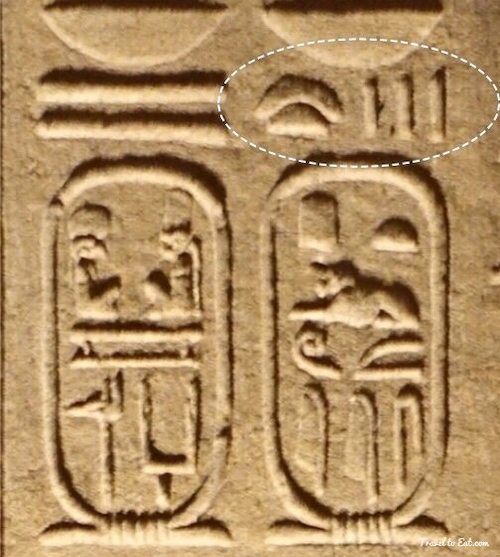

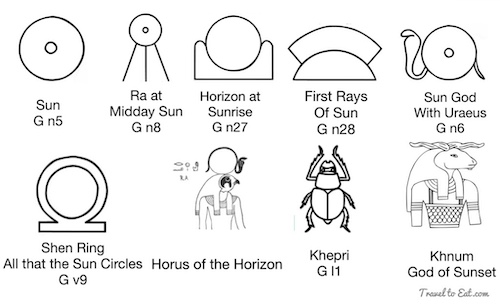
Above the nomen (family name) cartouche are three vertical lines indicating Ptolemy II is one of a line of men with the same name. The ancient Egyptian “Rising sun” hieroglyph is one of the oldest language hieroglyphs from Ancient Egypt. The Khepri sign is associated with the dawn and celebration of a new day or in this case a new pharoh. Khepri also represented creation and rebirth, and he was specifically connected with the rising sun and the mythical creation of the world. Khepri is a god in the ancient Egyptian religion connected to the scarab. Often, Khepri and another solar deity, Atum, were seen as aspects of Ra: Khepri was the morning sun, Ra was the midday sun, and Atum was the sun in the evening. Khnum is another God who is the god of rebirth, creation and the evening sun, although this is usually the function of Atum. In the New Kingdom, Hor-em-akhet (Horus in the Horizon) was the god of the rising and setting sun and is variously represented as a child, a falcon, or more commonly, as the leonine sphinx. The sun was important in ancient Egypt and the myths and gods morphed over time. In this case the symbol celebrates the coronation of Ptolemy II.
Other Symbols at the Temple of Isis from Philae
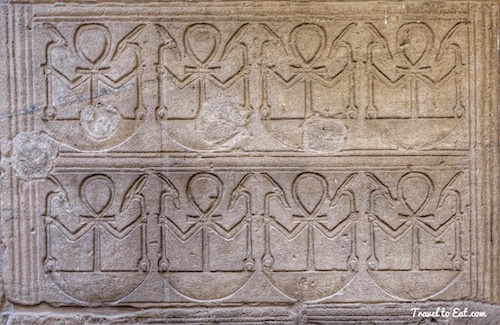
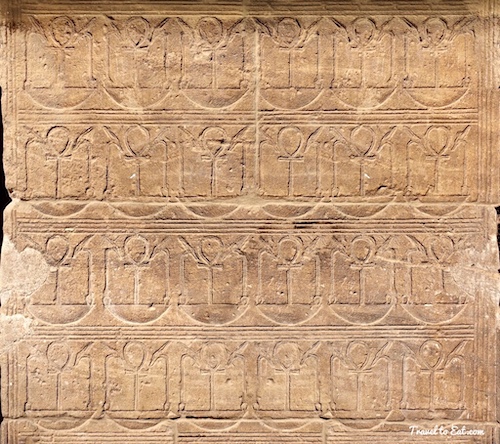
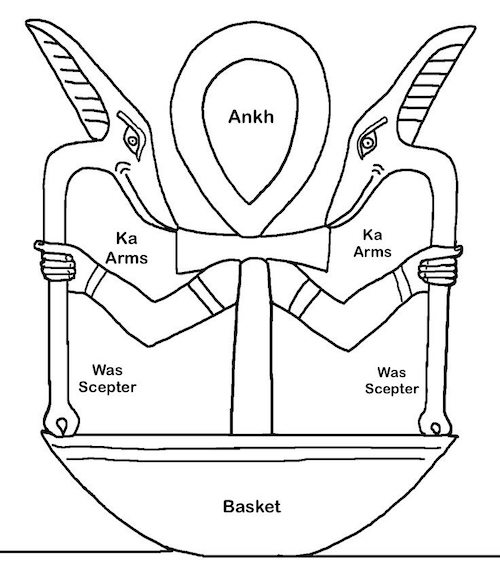
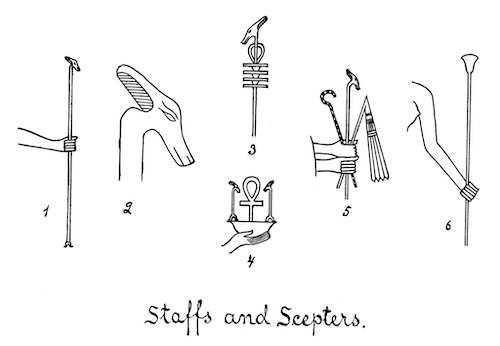
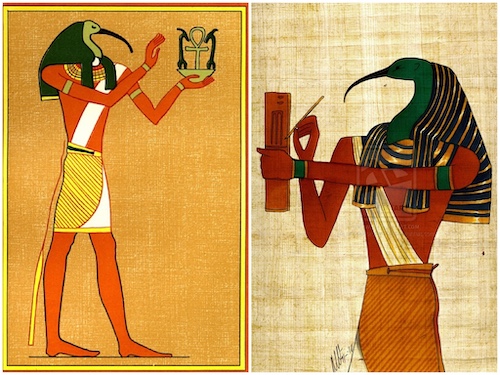
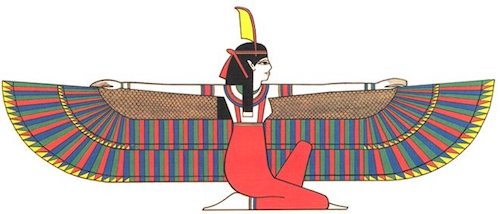
The “tcham” (Was) scepter is often seen in combination with the “ankh” and the “tet” or pillar of degrees, and a representation of Thoth, the scribe of the gods, shows this divinity holding a bowl, in which is seen the “ankh” enclosed on each side by a staff. The staff represents the Divine Truth in ultimates and thus the Letter of the Word which supports the internal sense and contains it in its fullness and power. This symbol was repeated throughout the Philae Temple as a decorative element both with and without the “ka” arms. Thoth played many vital and prominent roles in Egyptian mythology, such as maintaining the universe, and being one of the two deities (the other being Ma'at) who stood on either side of Ra's boat. In the later history of ancient Egypt, Thoth became heavily associated with the arbitration of godly disputes, the arts of magic, the system of writing, the development of science, and the judgment of the dead. In art, he was often depicted as a man with the head of an ibis or a baboon, animals sacred to him. Thoth was the patron of scribes who is described as the one “who reveals Maat and reckons Maat; who loves Maat and gives Maat to the doer of Maat”. Maat represents the ethical and moral principle that every Egyptian citizen was expected to follow throughout their daily lives. To the Egyptian mind, Maat bound all things together in an indestructible unity: the universe, the natural world, the state, and the individual were all seen as parts of the wider order generated by Maat. Pharaohs are often depicted with the emblems of Maat to emphasise their role in upholding the laws of the Creator.

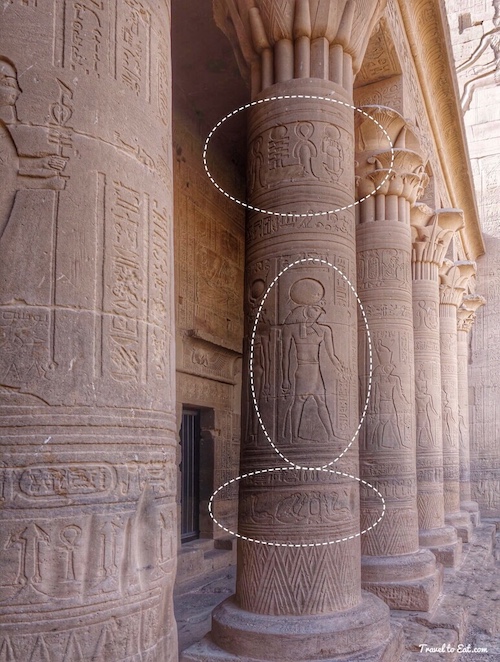
The pattern of the Two Ladies (Nekhbet and Wadjet or nebty name) discussed in a previous post is also used throughout the temple as a decorative element emphasizing the unity of Upper and Lower Egypt. As always, I hope you enjoyed, please leave a comment.
References:
Ottar Vendel: http://www.nemo.nu/ibisportal/0egyptintro/1egypt/
Land of Pyramids: http://www.landofpyramids.org/symbols-for-egypt.htm
Egyptian Symbols: http://www.egyptartsite.com/symlst.html
Odhner: http://highermeaning.org/Authors/CTOdhner/Egypt.shtml
Egyptian Myths: http://www.egyptianmyths.net/section-symbols.htm
Ancient Egypt: http://www.ancientegyptonline.co.uk/royalemblems.html
Hieroglyphs by Alphabetization: https://en.m.wikipedia.org/wiki/List_of_Egyptian_hieroglyphs_by_alphabetization
Sacred Egypt: http://sacredegypt.yolasite.com/resources/Egyptian%20Symbols%20and%20Colors.pdf
Egyptian Hieroglyphs: http://www.psifer.com/hier.htm
Horus Ra: http://www.whale.to/b/horus.html
Hieroglyphs: http://www.ancientscripts.com/egyptian.html
Hieroglyph Duscussion Board: http://www.unexplained-mysteries.com/forum/index.php?showtopic=264655
Hieroglyphic Writing: http://www.fltr.ucl.ac.be/FLTR/GLOR/octobre2013/LCA_01_Ecriture_EN.pdf
Gardiner: http://www.afrostyly.com/gardiner/list/

